Is It Possible to Restore a Heavily Polluted, Shallow, Urban Lake?
Abstract
1. Introduction
2. Material and Methods
2.1. Study Site
2.2. Water Sample Collection and Analysis
2.3. Bottom Sediment Collection
2.4. Bottom Sediment and Interstitial Water Sample Analysis
- -
- Labile phosphorus (NH4Cl-P; after 2 × 2 h extraction in 1 M NH4Cl),
- -
- Phosphorus sensitive for redox potential changes (BD-P; after 2 h extraction in 0.11 M buffered dithionite solution),
- -
- Phosphorus bound with aluminum and organic matter (NaOH-TP; after 16 h extraction in 0.1 M NaOH and mineralization of extract using the 10 N mixture of H2SO4 and HClO4),
- -
- Phosphorus bound with aluminum and iron oxides and hydroxides (NaOH-rP; directly in the NaOH extract),
- -
- Phosphorus bound with organic matter (NaOH-nrP; was calculated as the difference between NaOH-TP and NaOH-rP),
- -
- Calcium bound phosphorus (HCl-P; after 16 h extraction in 0.5 M HCl),
- -
- Residual phosphorus (res-P; was calculated as the difference between TP after mineralization using a mixture of H2SO4 and HClO4 and the sum of the fractions of NH4Cl-P, BD-P, NaOH-TP and HCl-P).
2.5. Studies of the Spatial Variability of Phosphorus and Nitrogen Concentrations in the Bottom Sediment
2.6. Studies of Heavy Metals and Persistent Organic Pollutant Contents
- No. 1—mixed sediment sample taken from stations 1–15, layers a (0–30 cm) and b (31–60 cm);
- No. 2—mixed sediment sample taken from stations 1–15, layers c (61–90 cm) and d (91–120 cm);
- No. 3—mixed sediment sample taken from stations 16–28, layers a (0–30 cm) and b (31–60 cm);
- No. 4—mixed sediment sample taken from stations 16–28, layers c (61–90 cm) and d (91–120 cm);
- No. 5—mixed sediment sample taken from station 5, layers a (0–30 cm) and b (31–60 cm);
- No. 6—mixed sediment sample taken from station 5, layers c (61–90 cm) and d (91–120 cm).
3. Results
3.1. Trophic Status
3.2. Phosphorus and Nitrogen Content in the Interstitial Water of Karczemne Lake
3.3. Density and Hydration of the Analyzed Bottom Sediment
3.4. Chemical Composition of Bottom Sediment of Karczemne Lake
3.5. Phosphorus Fractions in the Bottom Sediments
3.6. Stable Organic Pollutants (POPs), Polycyclic Aromatic Hydrocarbons (PAHs) and Heavy Metal Contents in the Sediments
3.7. Mass Calculation
4. Discussion
4.1. Reduction in Pollution Loads by Protective Methods
4.2. Conception of Restoration Treatments
5. Conclusions
Author Contributions
Funding
Acknowledgments
Conflicts of Interest
References
- Grochowska, J.; Tandyrak, R.; Wiśniewski, G. Long-term hydrochemical changes in a lake after the application of several protection measures in the catchment. Pol. J. Nat. Sci. 2014, 29, 251–263. [Google Scholar]
- Grochowska, J.; Augustyniak, R.; Łopata, M. How durable is the improvement of environmental conditions in a lake after the termination of restoration treatments. Ecol. Eng. 2017, 104, 23–29. [Google Scholar] [CrossRef]
- Huser, B.J.; Futter, M.N.; Wang, R.; Fölster, J. Persistent and widespread long-term phosphorus declines in Boreal lakes in Sweden. Sci. Total Environ. 2018, 613–614, 240–249. [Google Scholar] [CrossRef] [PubMed]
- Dodds, W.K.; Bouska, W.W.; Eitzmann, J.L.; Pilger, T.J.; Pitts, K.I.; Riley, A.J.; Schloesserv, J.A.; Thornbrugh, D.J. Eutrophication of U.S. freshwaters: Analysis of potential economic damages. Environ. Sci. Technol. 2009, 43, 12–19. [Google Scholar] [CrossRef]
- Liu, D.; Wang, P.; Wei, G.; Dong, W.; Hui, F. Removal of algal blooms from freshwater by the coagulation-magnetic separation method. Environ. Sci. Pollut. Res. 2013, 20, 60–65. [Google Scholar] [CrossRef]
- Huser, B.J.; Futter, M.; Lee, J.T.; Perniel, M. In-lake measures for phosphorus control: The most feasible and cost-effective solution for long-term management of water quality in urban lakes. Water Res. 2016, 97, 142–152. [Google Scholar] [CrossRef]
- Grochowska, J.; Brzozowska, R.; Łopata, M. Durability of changes in phosphorus compounds in water of an urban lake after application of two reclamation methods. Water Sci. Technol. 2013, 68, 234–239. [Google Scholar] [CrossRef]
- Grochowska, J.; Brzozowska, R. Influence of different recultivation methods on durability of nitrogen compounds changes in the waters of an urban lake. Water Environ. J. 2015, 29, 228–235. [Google Scholar] [CrossRef]
- Dunalska, J.A.; Grochowska, J.; Wiśniewski, G.; Napiórkowska-Krzebietke, A. Can we restore badly degraded urban lakes? Ecol. Eng. 2015, 82, 432–441. [Google Scholar] [CrossRef]
- Perkins, R.G.; Underwood, G.J.C. The potential for phosphorus release across the sediment-water interface in an eutrophic reservoir dosed with ferric sulphate. Water Res. 2001, 35, 1399–1406. [Google Scholar] [CrossRef]
- Younhai, W.; Yajun, W.; Jianxin, Z.; Yunying, W. Phosphorus release from lake sediments: Effects of pH, temperature and dissolved oxygen. KSCE J. Civ. Eng. 2014, 18, 323–329. [Google Scholar]
- Dunalska, J.A.; Wiśniewski, G. Can we stop the degradation of lakes? Innovative approaches in lake restoration. Ecol. Eng. 2016, 95, 714–722. [Google Scholar] [CrossRef]
- Kajak, Z. Hydrobiology–Limnology. In Inland Water Ecosystems; PWN: Warsaw, Poland, 2002; pp. 1–212. [Google Scholar]
- Lee, J.T. Minneapolis Chain of Lakes phosphorus reduction strategy. In Proceedings of the National Conference of Retrofit Opportunities for Water Resource Protection in Urban Environments, Chicago, IL, USA, 9–12 February 1998; USEPA, Office of Research Development: Washington, DC, USA, 1999. EPA/625/R-99/002. [Google Scholar]
- Cooke, G.D.; Welch, E.B.; Peterson, S.A.; Newroth, P.R. Restoration and Management of Lakes and Reservoirs; Taylor & Francis: Abingdon, UK; CRC Press: Boca Raton, FL, USA, 2005. [Google Scholar]
- Zamparas, M.; Zacharias, I. Restoration of eutrophic freshwater by managing internal nutrient loads. Sci. Total Environ. 2014, 496, 551–562. [Google Scholar] [CrossRef] [PubMed]
- Rosińska, J.; Kozak, A.; Dondajewska, R.; Kowalczewska-Madura, K. Water quality response to sustainable restoration measures Case study of urban Swarzędzkie Lake. Ecol. Indic. 2018, 84, 437–449. [Google Scholar] [CrossRef]
- Sheng-rui, W.; Xiangcan, J.; Haichao, Z.; Fengchang, W. Phosphorus fractions and its release in the sediments from the shallow lakes in the Middle and Lower Reaches of Yangtze River Area. Colloids Surf. A Physicochem. Eng. Asp. 2006, 273, 109–116. [Google Scholar]
- Siwek, H. Speciation analysis of phosphorus in bottom sediments–comparison of two methods. J. Elem. 2010, 15, 161–170. [Google Scholar]
- Xiaoli, W. Phosphorus fractionation and bio-availability in surface sediments from the Middle and Lower Reaches of the Yellow River. Procedia Environ. Sci. 2012, 12, 379–386. [Google Scholar]
- Klapper, H. Technologies for lake restoration. J. Limnol. 2003, 62, 73–90. [Google Scholar] [CrossRef]
- Environmental Monitoring Library. Report of the Voivodship Inspectorate for Environmental Protection; Environmental Monitoring Library: Bydgoszcz, Poland, 2003; pp. 1–182. ISBN 83-7217-204-8. [Google Scholar]
- Björk, S. Lake restoration techniques—Proceedings of the International Congress on Lake Pollution and Recovery. In Proceedings of the European Water Pollution Control Association, Rome, Italy, 15–18 April 1985; pp. 202–212. [Google Scholar]
- Björk, S.; Pokorný, J.; Hauser, V. Restoration of lakes through sediment removal, with case studies from lakes Trummen, Sweden and Vajgar, Czech Republic. In Restoration of Lakes, Streams, Floodplains, and Bogs in Europe. Principles and Case Studies; Eiseltová, M., Ed.; Springer: Berlin/Heidelberg, Germany, 2010. [Google Scholar]
- Kondracki, J. Physical Geography of Poland; PWN: Warsaw, Poland, 2011; pp. 1–463. [Google Scholar]
- Wołos, A.; Mioduszewska, H. Impact of anglers using groundbaits on fishing effects and nutrient balance of aquatic ecosystems. Fish. Announc. 2003, 1, 23–27. [Google Scholar]
- Vollenweider, R.A. Advances In defining critical loading level for phosphorus in lake eutrophication. Mem. INST. Ital. Hydrobiol. 1976, 33, 53–83. [Google Scholar]
- Carlson, R.E. A trophic state index for lakes. Limnol. Oceanogr. 1977, 22, 361–369. [Google Scholar] [CrossRef]
- Kratzer, C.R.; Brezonik, P.L. A Carlson—Type trophic state index for nitrogen in Florida lakes. Water Res. Bull. 1981, 17, 713–715. [Google Scholar] [CrossRef]
- Kaca, E. Measurements of water flow volume and mass of substance contained in it, and its uncertainty on the example of fish ponds. Water Environ. Rural Areas 2003, 13, 31–57. [Google Scholar]
- Brzozowska, R.; Gawrońska, H. The influence of a long-term artificial aeration on th nitrogen compounds exchange between bottom sediments and water in Lake Długie. Oceanol. Hydrobiol. Stud. 2009, 38, 113–119. [Google Scholar] [CrossRef]
- Rydin, E.; Welch, E.B. Aluminum dose required to inactivate phosphate in lake sediments. Water Res. 1998, 32, 2969–2976. [Google Scholar] [CrossRef]
- Van Hullebush, E.; Auvray, F.; Deluchat, V.; Chazal, P.M.; Baudu, M. Phosphorus fractionation and short-term mobility in the surface sediment of a polymictic shallow lake treated with a low dose of alum (Courtille Lake, France). Water Air Soil Pollut. 2003, 146, 75–91. [Google Scholar] [CrossRef]
- Hermanowicz, W.; Dożańska, W.; Dojlido, J.; Koziorowski, B.; Zerbe, J. Physico-Chemical Study of Water and Wastewater; Arkady: Warsaw, Poland, 1999. [Google Scholar]
- Tibco Software Inc. STATISTICA Version 13.0. 2018. Available online: https://www.tibco.com/resources/product-download/tibco-statistica-trial-download-windows (accessed on 5 June 2018).
- EPA. Parameters of Water Quality. Interpretation and Standards; Environmental Protection Agency: Wexford, Ireland, 2001.
- Wolfram MathWorld-web’s most extensive mathematic. Available online: https://mathworld.wolfram.com/VoronoiDiagram.html resources (accessed on 5 April 2020).
- Ordinance of the Ministry of the Environment of 11 May 2015 on the recovery of waste outside installations and equipment. J. Laws 2015 (Set log 2015, item 796); 2015. Available online: http://prawo.sejm.gov.pl/isap.nsf/download.xsp/WDU20150000796/O/D20150796.pdf resources (accessed on 5 April 2020).
- Ordinance of the Ministry of the Environment of 1 September 2016 on the method of conducting an assessment of the soil surface pollution. J. Laws 2016 (Set log 2016, item 1395); 2016. Available online: http://prawo.sejm.gov.pl/isap.nsf/download.xsp/WDU20160001395/O/D20161395.pdf (accessed on 5 April 2020).
- Augustyniak, R.; Neugebauer, M.; Kowalska, J.; Szymański, D.; Wiśniewski, G.; Filipkowska, Z.; Grochowska, J.; Łopata, M.; Parszuto, K.; Tandyrak, R. Bottom deposits of stratified, seepage, urban lake (on the example of Tyrsko Lake, Poland) as a factor potentially shaping lake water quality. J. Ecol. Eng. 2015, 18, 55–62. [Google Scholar] [CrossRef][Green Version]
- Directive, W.F. Directive 2000/60/EC of the European Parliament and of the Council of 23 October 2000 establishing a framework for Community action in the field of water policy. Off. J. Eur. Communities 2000, 22, 1–73. [Google Scholar]
- Kowalczewska-Madura, K.; Dondajewska, R.; Gołdyn, R.; Kozak, A.; Messyasz, B. Internal phosphorus loading from the bottom sediments of a dimictic lake during its sustainable restoration. Water Air Soil Pollut. 2018, 229. [Google Scholar] [CrossRef]
- Smal, H.; Ligęza, S.; baran, S.; Wójcikowska-Kapusta, A.; Obroślak, R. Nitrogen and phosphorus in bottom sediments of two small dam reservoir. Pol. J. Environ. Stud. 2013, 22, 1479–1489. [Google Scholar]
- Ishii, Y.; Yabe, T.; Nakamura, M.; Amano, Y.; Komatsu, N.; Watanabe, K. Effect of nitrate mobilization from bottom sediment in shallow eutrophic lakes. J. Water Environ. Technol. 2009, 7, 75–83. [Google Scholar] [CrossRef]
- Bojakowska, I. Phosphorus in lake sediments of Poland—Results of monitoring research. Limnol. Rev. 2016, 16, 15–25. [Google Scholar] [CrossRef][Green Version]
- Grochowska, J.; Brzozowska, R.; Grzybowski, M.; Napiórkowska-Krzebietke, A.; Bigaj, I.; Szymański, D.; Zieliński, R. Physicochemical Tests of Water and Bottom Sediments as well as Hydrological Measurements of 4 Lakes: Mielenko, Tavern, Large and Small Monastery and Their Catchments in Terms of the Possibility of Reservoir Protection against Degradation; Commune Office in Kartuzy: Kartuzy, Poland, 2013; Typescript, not published data. [Google Scholar]
- Kentzer, A. Phosphorus and Its Biologically Available Fractions in Lake Sediments of Various Trophies; UMC: Toruń, Poland, 2001; pp. 1–111. [Google Scholar]
- Brzozowska, R.; Gawrońska, H. Influence of a multi-year artificial aeration of a lake using destratification method on the sediment-water phosphorus exchange. Arch. Environ. Prot. 2005, 31, 71–88. [Google Scholar]
- Şahin, Y.; Demirak, A.; Keskin, F. Phosphorus fractions and its potential release in the sediments of Koycegiz Lake, Turkey. Lakes Reserv. Ponds 2012, 6, 139–153. [Google Scholar]
- Augustyniak, R. The Influence of Physico-Chemical and Microbiological Factors on Internal Supply of Phosphorus in Selected Urban Lakes; Committee of Environmental Engineering of the Polish Academy of Sciences: Lublin, Poland, 2018; Volume 140, pp. 1–230. [Google Scholar]
- Jucherski, A.; Walczowski, A. Influence of selected macrophytes on sewage treatment effectiveness in the slope soil-vegetation filtration beds. Probl. Agric. Eng. 2012, 20, 115–124. [Google Scholar]
- Gałka, B.; Witkowski, M. Characteristics of bottom sediments of the Młyny dam reservoir and the possibility of its agricultural use. Water Environ. Rural Areas 2010, 10, 53–63. [Google Scholar]
- Maj, K.; Koszelnik, P. Methods of the management of bottom sediment. J. Civ. Eng. Environ. Archit. 2016, 63, 157–169. [Google Scholar]
- Eymontt, A.; Wierzbicki, K. Hydromechanical technology of bottom sediment mining. Probl. Agric. Eng. 2017, 4, 19–27. [Google Scholar]
- Gawrońska, H.; Łopata, M.; Jaworska, B. The effectiveness of the phosphorus inactivation method in reducing the trophy of lakes of different morphometrical and hydrological features. Limnol. Rev. 2007, 7, 27–34. [Google Scholar]
- Grochowska, J.; Augustyniak, R.; Łopata, M.; Parszuto, K.; Tandyrak, R.; Płachta, A. From saprotrophic to clear water status: The restoration path of a degraded urban lake. Water Air Soil Pollut. 2019. [Google Scholar] [CrossRef]
- Rydin, E.; Welch, E.B. Dosing alum to Wisconsin lake sediments based on in vitro formation of aluminum bound phosphate. Lake Reserv. Manag. 1999, 15, 324–331. [Google Scholar] [CrossRef]
- Gawrońska, H.; Brzozowska, R.; Grochowska, J.; Lossow, K. Effectiveness of PAX and PIX coagulants in phosphorus reduction in a lake—Laboratory experiments. Limnol. Rev. 2001, 1, 73–82. [Google Scholar]
- Gołdyn, R. Biomanipulation in water reservoirs as a method of reclamation. Munic. Rev. 2007, 6, 70–72. [Google Scholar]



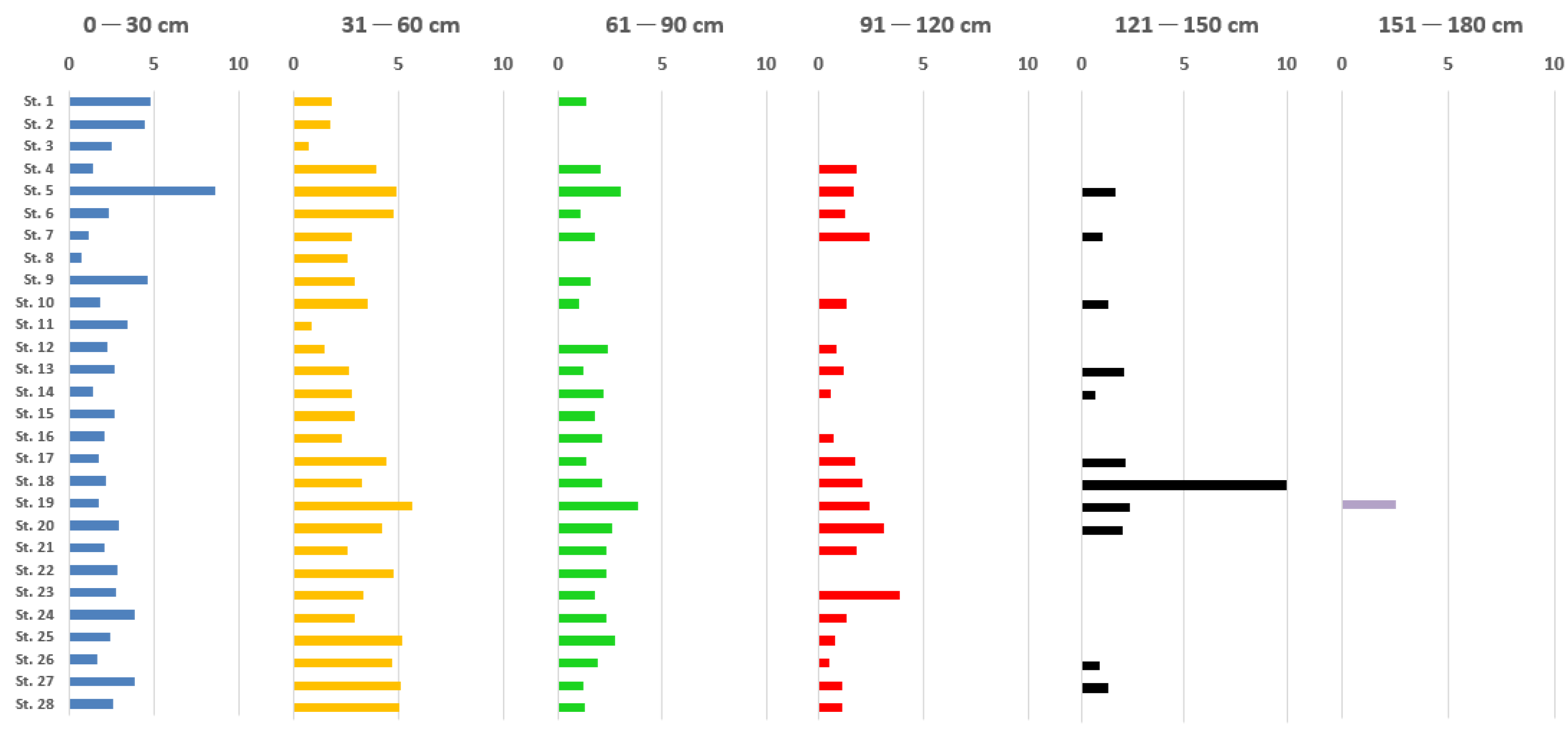


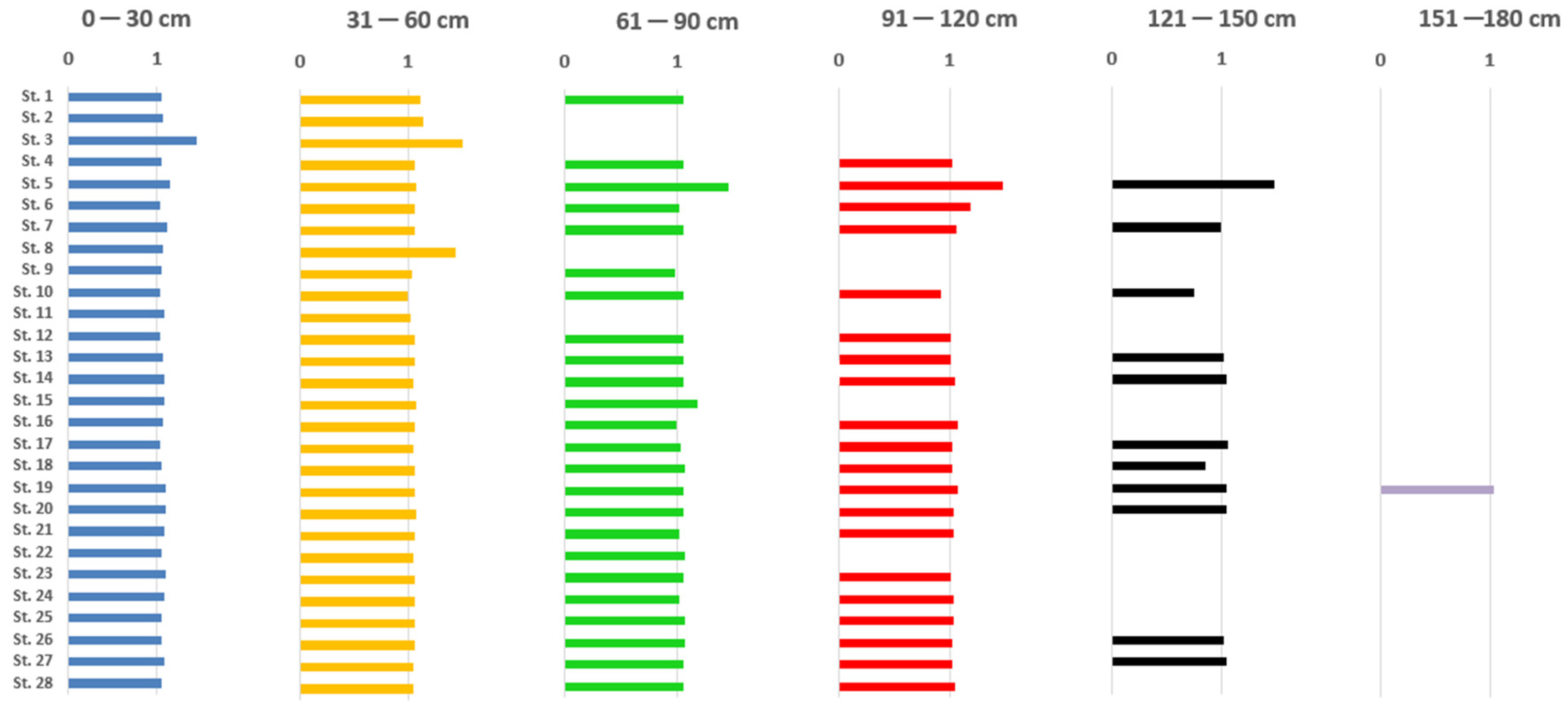

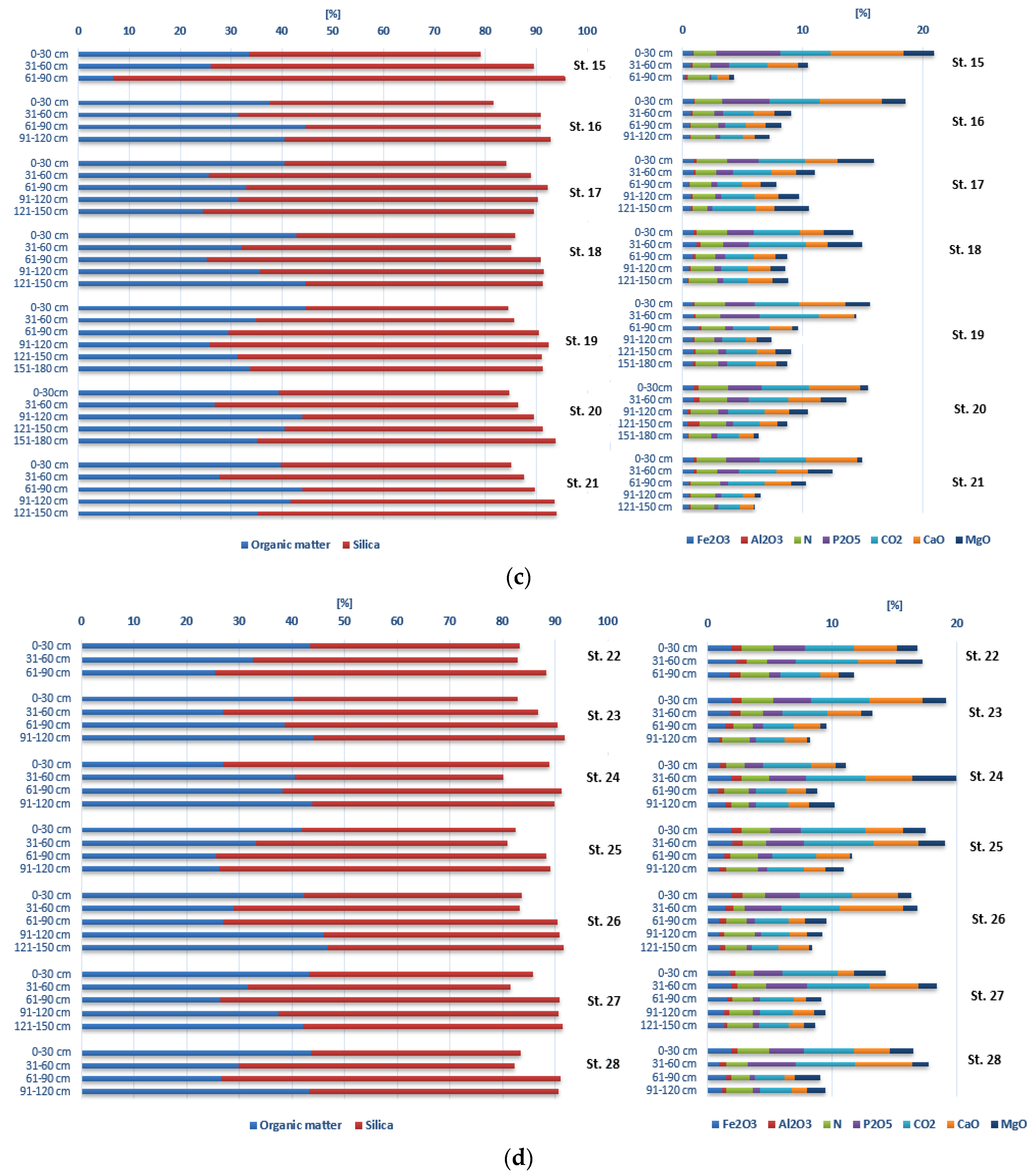
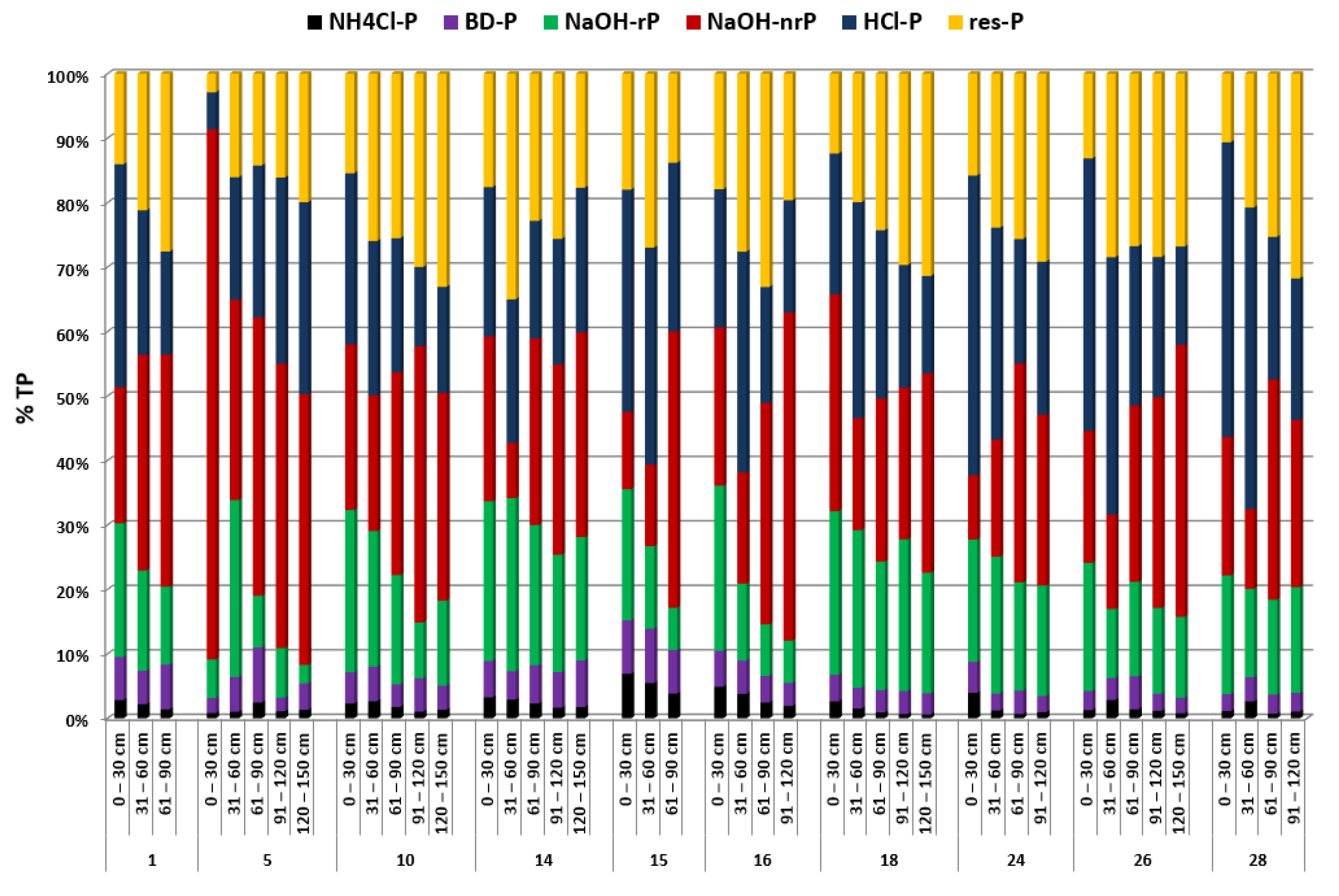
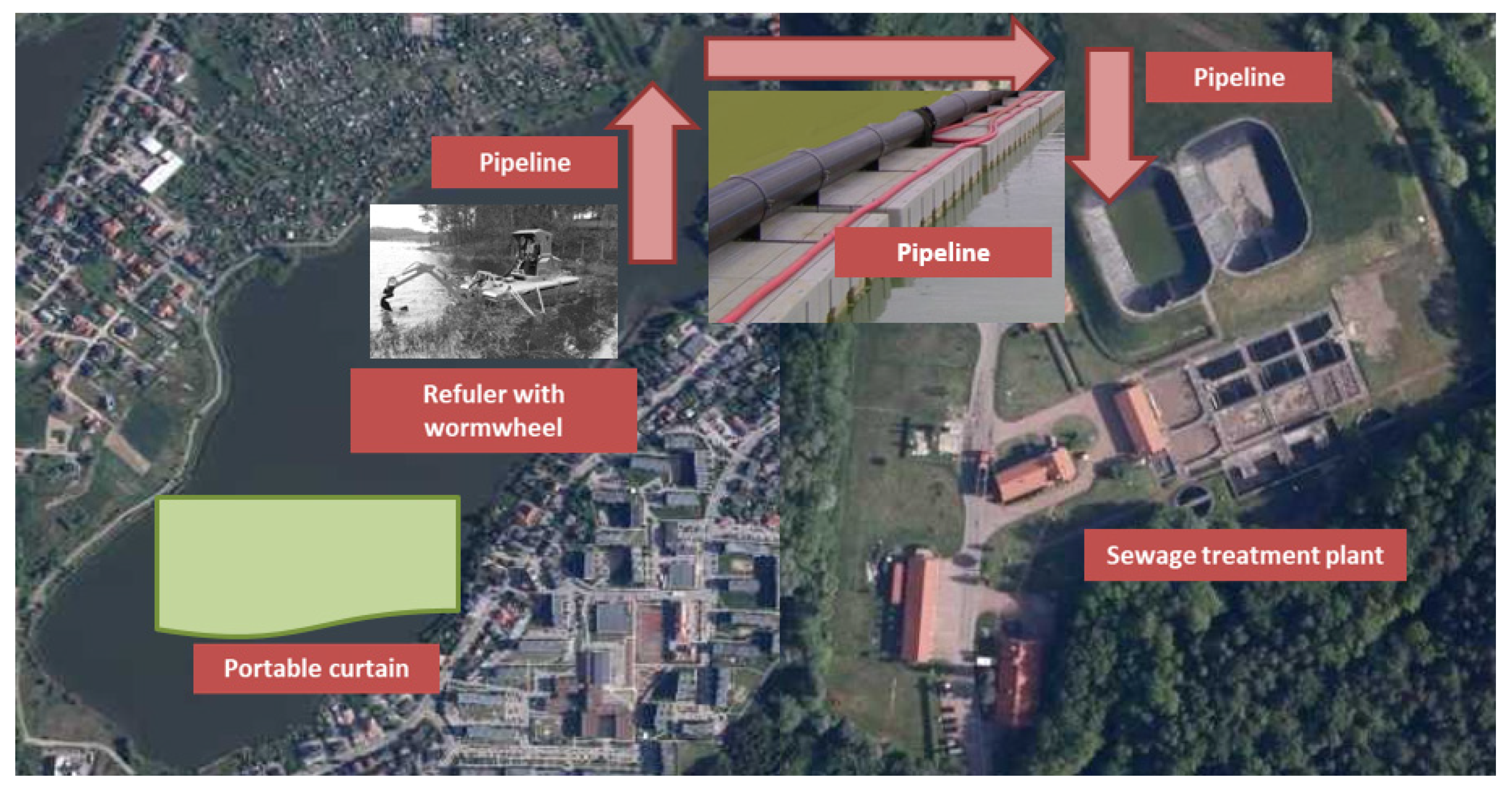
| Parameter | Value |
|---|---|
| Elevation of normal water table (m AMSL) | 203.7 |
| Lake surface (ha) | 40.4 |
| Maximum depth (m) | 3.2 |
| Average depth (m) | 1.98 |
| Relative depth | 0.0050 |
| Depth indicator | 0.62 |
| Volume (in thousand m3) | 798.3 |
| Maximum length (m) | 1282 |
| Maximum width (m) | 445 |
| Elongation indicator | 2.9 |
| Average width (m) | 315 |
| Shoreline length (m) | 3163 |
| Indicator of shoreline development | 1.4 |
| Point Number | Latitude | Longitude |
|---|---|---|
| 1 | N:54°33′27.5″ | E: 18°19′61.4″ |
| 2 | N:54°33′19.0″ | E:18°19′51.1″ |
| 3 | N:54°33′16.9″ | E:18°19′25.3″ |
| 4 | N:54°33′10.6″ | E:18°19′41.0″ |
| 5 | N:54°33′01.8″ | E:18°19′58.5″ |
| 6 | N:54°33′08.5″ | E:18°19′14.3″ |
| 7 | N:54°33′02.3″ | E:18°19′30.5″ |
| 8 | N:54°32′96.3″ | E:18°19′45.3″ |
| 9 | N:54°33′00.3″ | E:18°19′04.0″ |
| 10 | N:54°32′93.9″ | E:18°19′19.7″ |
| 11 | N:54°32′87.9″ | E:18°19′35.0″ |
| 12 | N:54°32′91.8″ | E:18°18′93.8″ |
| 13 | N:54°32′85.7″ | E:18°19′09.6″ |
| 14 | N:54°32′79.4″ | E:18°19′24.3″ |
| 15 | N:54°32′95.5″ | E:18°18′75.4″ |
| 16 | N:54°32′83.4″ | E:18°18′83.2″ |
| 17 | N:54°32′77.0″ | E:18°18′98.9″ |
| 18 | N:54°32′75.5″ | E:18°19′13.1″ |
| 19 | N:54°32′71.0″ | E:18°19′14.3″ |
| 20 | N:54°32′74.8″ | E:18°18′72.9″ |
| 21 | N:54°32′68.8″ | E:18°18′88.6″ |
| 22 | N:54°32′62.6″ | E:18°19′03.7″ |
| 23 | N:54°32′66.7″ | E:18°18′63.1″ |
| 24 | N:54°32′60.3″ | E:18°18′78.9″ |
| 25 | N:54°32′54.1″ | E:18°18′94.0″ |
| 26 | N:54°32′58.2″ | E:18°18′52.5″ |
| 27 | N:54°32′51.7″ | E:18°18′68.2″ |
| 28 | N:54°32′43.7″ | E:18°18′58.6″ |
| Parameter | Norm | SampleNo. 1 | SampleNo. 2 | SampleNo. 3 | SampleNo. 4 | SampleNo. 5 |
|---|---|---|---|---|---|---|
| As | <30 mg/kg d.w. | 9.77 | 5.0 | 13.3 | 6.05 | 12.7 |
| Cr | <200 mg/kg d.w. | 29.1 | 18.8 | 40.1 | 33.2 | 44.1 |
| Zn | <1000 mg/kg d.w. | 406.0 | 104.0 | 503.0 | 152.0 | 843.0 |
| Cd | <7.5 mg/kg d.w. | 0.543 | 0.050 | 0.794 | 0.050 | 0.846 |
| Cu | <150 mg/kg d.w. | 93.5 | 25.9 | 123.0 | 38.4 | 247.0 |
| Ni | <75 mg/kg d.w. | 19.9 | 13.8 | 25.8 | 21.9 | 22.5 |
| Pb | <200 mg/kg d.w. | 97.2 | 31.6 | 126.0 | 49.4 | 317.0 |
| Hg | <1.0 mg/kg d.w. | 0.60 | 0.22 | 0.68 | 0.26 | 0.30 |
| Benzo(a) anthracene | <1.5 mg/kg d.w. | 1.13 | 0.361 | 1.69 | 0.240 | 13.0 |
| Benzo(b) fluoranthene | <1.5 mg/kg d.w. | 1.88 | 0.69 | 3.57 | 0.55 | 14.40 |
| Benzo(k) fluoranthene | <1.5 mg/kg d.w. | 0.803 | 0.270 | 1.380 | 0.246 | 5.770 |
| Benzo(g, h, i) perylene | <1.0 mg/kg d.w. | 1.44 | 0.548 | 2.65 | 0.72 | 7.34 |
| Benzo(a) pyrene | <1.0 mg/kg d.w. | 1,21 | 0.410 | 2.10 | 0.39 | 9.75 |
| Dibenzo(a, h) anthracene | <1.0 mg/kg d.w. | 0.297 | 0.020 | 0.482 | 0.020 | 3.24 |
| Indeno(1, 2, 3-c,d) pyrene | <1.0 mg/kg d.w. | 1.75 | 0.976 | 1.86 | 0.916 | 8.03 |
| Number of Sampling Point | Sector Area (m2) | The Thickness of Layer to Be Removed (m) | Volume of the Layer to Be Removed (m3) | Wet Sludge Mass to Be Removed (kg m−2) | Dry Sludge Mass to Be Removed (kg m−2) |
|---|---|---|---|---|---|
| 1 | 10,273 | 0.5 | 5136.5 | 5,575,868.5 | 710,711.3 |
| 2 | 15,100 | 0.5 | 7550 | 828,312.1 | 1,516,022.2 |
| 3 | 6000 | 0.5 | 3000 | 4,413,593.9 | 2,830,379.8 |
| 4 | 11,345 | 0.6 | 6807 | 722,245.9 | 437,108.8 |
| 5 | 11,495 | 0.6 | 6897 | 7,727,772.4 | 1,394,499.5 |
| 6 | 12,500 | 0.6 | 7500 | 7,980,278.1 | 703,813.3 |
| 7 | 18,600 | 0.6 | 11,160 | 1,216,534.6 | 962,287.8 |
| 8 | 8200 | 0.5 | 4100 | 5,010,261.5 | 1,811,746.2 |
| 9 | 15,900 | 0.6 | 9540 | 9,947,672.0 | 1,012,203.0 |
| 10 | 14,770 | 0.75 | 11,077.5 | 1,136,233.6 | 1,022,676.0 |
| 11 | 6080 | 0.6 | 3648 | 385,594.4 | 379,970.6 |
| 12 | 16,100 | 0.6 | 9660 | 1,014,576.2 | 886,400.8 |
| 13 | 12,800 | 0.75 | 9600 | 10,225,571.2 | 923,673.7 |
| 14 | 9280 | 0.9 | 8352 | 8,857,878.2 | 672,286.9 |
| 15 | 10,650 | 0.6 | 6390 | 6,914,467.2 | 634,595.0 |
| 16 | 13,600 | 0.5 | 6800 | 8,700,205.6 | 682,288.6 |
| 17 | 15,950 | 0.6 | 9570 | 10,052,152.6 | 817,790.2 |
| 18 | 5020 | 0.9 | 4518 | 4,794,241.8 | 445,579.2 |
| 19 | 6900 | 0.75 | 5175 | 5,566,142.9 | 402,880.1 |
| 20 | 11,900 | 0.9 | 10,710 | 11,550,996.8 | 952,646.0 |
| 21 | 12,880 | 0.9 | 11,592 | 12,182,956.9 | 979,039.5 |
| 22 | 11,540 | 0.75 | 8655 | 9,116,970.7 | 719,112.3 |
| 23 | 12,670 | 0.75 | 9502.5 | 10,270,607.7 | 912,577.6 |
| 24 | 16,100 | 0.9 | 14,490 | 15,329,075.7 | 1,277,107.1 |
| 25 | 11,600 | 0.9 | 10,440 | 11,070,268.6 | 945,021.8 |
| 26 | 23,750 | 0.6 | 14,250 | 15,094,698.4 | 1,111,633.9 |
| 27 | 26,320 | 0.6 | 15,792 | 16,859,229.9 | 1,158,047.5 |
| 28 | 13,500 | 0.6 | 8100 | 8,529,586.9 | 615,247.2 |
| Total | 360,823 | - | 240,013 | 2,588,054.7 Mg | 269,173.5 Mg |
| Number of Sampling Point | Sector Area (m2) | The Content of TP in Bottom Sediment | The Content of TN in Bottom Sediment | The Content of TP in Interstitial Water | The Content of TN in Interstitial Water | ||||
|---|---|---|---|---|---|---|---|---|---|
| kg P m−2 | kg P sector−1 | kg N m−2 | kg N sector−1 | g P m−2 | kg P sector−1 | g N m−2 | kg N sector−1 | ||
| 1 | 10,273 | 0.46 | 4691.2 | 0.94 | 9697.7 | 1.62 | 16.66 | 10.60 | 109.28 |
| 2 | 15,100 | 0.49 | 7468.5 | 1.12 | 16,966.2 | 1.45 | 21.86 | 7.68 | 116.02 |
| 3 | 6000 | 0.6 | 3769.7 | 1.47 | 8830.2 | 0.68 | 4.06 | 5.11 | 30.67 |
| 4 | 11,345 | 0.48 | 5439.5 | 0.83 | 9365.5 | 1.52 | 17.25 | 13.70 | 155.35 |
| 5 | 11,495 | 2.09 | 24,007.2 | 1.15 | 13,180.0 | 3.34 | 38.44 | 22.60 | 259.46 |
| 6 | 12,500 | 0.55 | 6874.1 | 0.89 | 11,157.5 | 1.92 | 24.06 | 14.10 | 176.74 |
| 7 | 18,600 | 0.36 | 6636.8 | 0.90 | 16,760.7 | 1.07 | 19.94 | 11.80 | 219.26 |
| 8 | 8200 | 0.45 | 3657.5 | 0.49 | 4050.8 | 0 | 0 | 0 | 0 |
| 9 | 15,900 | 0.52 | 8290.4 | 1.10 | 17,477.6 | 2.03 | 32.25 | 8.33 | 132.49 |
| 10 | 14,770 | 0.46 | 6825.0 | 1.24 | 18,387.5 | 1.61 | 23.82 | 11.90 | 176.41 |
| 11 | 6080 | 0.92 | 5622.0 | 1.02 | 6223.1 | 0.95 | 5.77 | 3.81 | 23.15 |
| 12 | 16,100 | 0.40 | 6495.5 | 1.05 | 16,854.2 | 1.03 | 16.55 | 14.40 | 232.24 |
| 13 | 12,800 | 0.49 | 6276.8 | 1.44 | 18,369.0 | 1.62 | 20.75 | 17.90 | 229.39 |
| 14 | 9280 | 0.79 | 7361.0 | 1.48 | 13,706.1 | 1.75 | 16.24 | 33.70 | 312.44 |
| 15 | 10,650 | 0.77 | 8215.0 | 1.00 | 10,636.5 | 1.53 | 16.26 | 8.28 | 88.22 |
| 16 | 13,600 | 0.43 | 5860.4 | 0.97 | 13,139.7 | 1.21 | 16.45 | 10.70 | 146.09 |
| 17 | 15,950 | 0.39 | 6199.2 | 0.96 | 15,312.6 | 0.68 | 26.87 | 9.01 | 143.67 |
| 18 | 5020 | 0.57 | 2870.8 | 1.61 | 8087.3 | 2.04 | 10.22 | 27.20 | 136.37 |
| 19 | 6900 | 0.59 | 4052.4 | 1.20 | 8280.0 | 2.57 | 17.71 | 27.20 | 187.60 |
| 20 | 11,900 | 0.58 | 6852.3 | 1.62 | 19,283.5 | 2.68 | 31.88 | 23.40 | 277.93 |
| 21 | 12,880 | 0.52 | 6693.0 | 1.58 | 20,405.3 | 1.91 | 24.61 | 22.60 | 291.16 |
| 22 | 11,540 | 0.52 | 5952.7 | 1.31 | 15,134.8 | 2.44 | 28.18 | 29.50 | 339.86 |
| 23 | 12,670 | 0.55 | 6926.7 | 1.32 | 16,781.5 | 1.90 | 24.07 | 16.80 | 213.24 |
| 24 | 16,100 | 0.59 | 9531.7 | 1.57 | 25,236.6 | 2.52 | 40.64 | 27.40 | 441.00 |
| 25 | 11,600 | 0.73 | 8413.8 | 1.75 | 20,258.9 | 2.84 | 32.94 | 36.50 | 423.60 |
| 26 | 23,750 | 0.57 | 13,646.0 | 0.55 | 12,975.1 | 1.75 | 41.62 | 14.60 | 347.12 |
| 27 | 26,320 | 0.54 | 14,224.2 | 0.82 | 21,536.3 | 2.51 | 66.03 | 21.90 | 576.67 |
| 28 | 13,500 | 0.68 | 9168.3 | 0.85 | 11,464.8 | 2.13 | 28.72 | 20.80 | 281.20 |
| Total | 360,823 | - | 212.2 Mg | - | 399.6 Mg | - | 0.66 Mg | - | 6.07 Mg |
| TOTAL P 212.86 Mg | |||||||||
| TOTAL N 405.70 Mg | |||||||||
© 2020 by the authors. Licensee MDPI, Basel, Switzerland. This article is an open access article distributed under the terms and conditions of the Creative Commons Attribution (CC BY) license (http://creativecommons.org/licenses/by/4.0/).
Share and Cite
Grochowska, J.; Augustyniak, R.; Łopata, M.; Tandyrak, R. Is It Possible to Restore a Heavily Polluted, Shallow, Urban Lake? Appl. Sci. 2020, 10, 3698. https://doi.org/10.3390/app10113698
Grochowska J, Augustyniak R, Łopata M, Tandyrak R. Is It Possible to Restore a Heavily Polluted, Shallow, Urban Lake? Applied Sciences. 2020; 10(11):3698. https://doi.org/10.3390/app10113698
Chicago/Turabian StyleGrochowska, Jolanta, Renata Augustyniak, Michał Łopata, and Renata Tandyrak. 2020. "Is It Possible to Restore a Heavily Polluted, Shallow, Urban Lake?" Applied Sciences 10, no. 11: 3698. https://doi.org/10.3390/app10113698
APA StyleGrochowska, J., Augustyniak, R., Łopata, M., & Tandyrak, R. (2020). Is It Possible to Restore a Heavily Polluted, Shallow, Urban Lake? Applied Sciences, 10(11), 3698. https://doi.org/10.3390/app10113698







